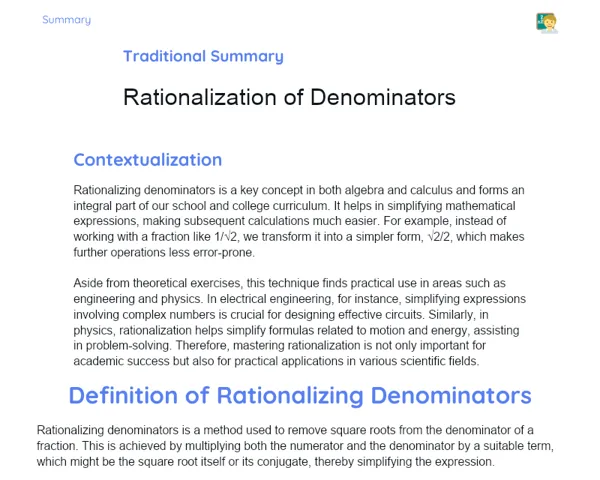Summary Tradisional | Area: Trapezoid
Contextualization
Today we will explore the calculation of the area of a trapezoid, a common and practical geometric shape. A trapezoid is a four-sided figure with two sides that are parallel, known as bases. We call the longer base 'B' and the shorter base 'b'. The height 'h' is the perpendicular distance between these bases. Understanding this concept is vital for various practical scenarios, whether it's calculating the area of fields, floors, or other trapezoidal surfaces.
Mastering how to find the area of a trapezoid is important not just in mathematics but also in professions like architecture and engineering. For instance, in construction work, trapezoidal shapes often appear, and knowing their area helps in determining the quantity of materials needed, like concrete or tiles. Moreover, the formula for the trapezoid's area is a handy tool for solving everyday problems, such as assessing garden spaces or rooms with uneven shapes.
To Remember!
Definition of Trapezoid
A trapezoid is a four-sided shape with two parallel sides called bases. The longer base is denoted as 'B', and the shorter one is 'b'. The remaining two sides can be unequal and are termed oblique sides. The height 'h' is the vertical distance between the two parallel bases.
Recognizing the structure of a trapezoid is essential for calculating its area. Being a common geometric form, the trapezoid finds applications in fields like architecture, civil engineering, and design. Identifying and measuring its elements is the crucial first step in tackling practical situations involving this shape.
Additionally, understanding what constitutes a trapezoid aids in distinguishing it from other quadrilaterals, like parallelograms and rectangles, which showcase different properties. A clear grasp of its bases and height is key to properly applying the area formula.
-
A trapezoid has two parallel bases: the longer base (B) and the shorter base (b).
-
The height (h) is the vertical distance between the two bases.
-
The non-parallel sides are referred to as oblique sides.
Elements of the Trapezoid
The primary elements of a trapezoid consist of the bases (B and b) and the height (h). The bases, being the parallel sides of the trapezoid, are crucial for area calculations. The height, being the perpendicular distance between the bases, is also a significant part of the area formula.
Along with the bases and height, the oblique sides don't overlap but help in accurately defining the trapezoid's shape and may be useful in specific contexts, like calculating perimeter or more intricate geometric challenges.
Grasping these elements and how they interrelate is imperative for tackling problems involving trapezoids. Practicing the identification and measurement of these parts will enable students to apply the area formula correctly and deepen their understanding of trapezoidal geometry.
-
Bases (B and b) are the parallel sides of the trapezoid.
-
Height (h) is the perpendicular distance separating the bases.
-
Oblique sides are the non-parallel edges of the trapezoid.
Area Formula of the Trapezoid
The formula to calculate the area of a trapezoid is S = (B + b) * h / 2, where 'S' denotes the area, 'h' is the height, 'B' is the longer base, and 'b' represents the shorter base. This formula emerges from the combined areas of a rectangle and two triangles created when the trapezoid is divided.
To ensure the formula is applied correctly, it is vital to accurately measure both bases and the height. You sum the lengths of the bases and multiply by the height, with the result divided by 2. This ensures the area you calculate accurately reflects the trapezoid's surface.
Practicing this formula with diverse problems will reinforce students' understanding. Practical examples, like calculating the area of fields or gardens, serve to illustrate how this formula can be used in real-life situations.
-
The area formula for the trapezoid is S = (B + b) * h / 2.
-
Accurate measurement of the bases and height is crucial for properly applying the formula.
-
Engaging with practical examples solidifies the understanding of the formula.
Application in Practical Problems
The trapezoid area formula finds extensive use in practical problems, such as determining the area of a trapezoidal plot of land or garden. Knowing the area is essential for calculating the quantity of materials like grass, concrete, or tiles required.
Additionally, in fields like architecture and engineering, grasping the area of trapezoids is critical for spatial planning. Trapezoidal surfaces frequently appear in construction projects, and accurately calculating their areas is fundamental to project success.
Applying this formula to real problems helps students appreciate the relevance of mathematics in everyday life. Solving real-world issues using the trapezoid's area formula makes learning meaningful and showcases the practical importance of mathematical skills.
-
The formula is valuable for determining the area of trapezoidal lands and gardens.
-
In architecture and engineering, it's crucial for spatial planning.
-
Applying the formula to real issues enhances the significance of learning.
Key Terms
-
Trapezoid: A four-sided shape with two parallel bases.
-
Longer Base (B): The longer of the two parallel bases in the trapezoid.
-
Shorter Base (b): The shorter of the two parallel bases in the trapezoid.
-
Height (h): The perpendicular distance between the bases of the trapezoid.
-
Oblique Sides: The non-parallel sides of the trapezoid.
-
Area Formula: S = (B + b) * h / 2, used for calculating the trapezoid's area.
Important Conclusions
In this lesson, we delved into how to compute the area of a trapezoid using the formula S = (B + b) * h / 2. We covered the definition and key elements of a trapezoid, encompassing the bases, height, and oblique sides. Real-life examples, such as calculating area for fields and gardens, highlighted the practical uses of this knowledge.
The trapezoid area formula is a vital tool across various fields like architecture, engineering, and design. Being able to compute the area of trapezoidal shapes plays an essential part in planning and executing projects within these domains. This practical application emphasizes the relevance of mathematical understandings in everyday scenarios.
Finally, our lesson underscored the importance of mathematics in resolving daily challenges and how valuable calculating the area of trapezoids can be. We urge students to keep exploring this topic and practice applying the formula in numerous contexts to solidify their learning.
Study Tips
-
Practice solving different problems that require calculating the area of trapezoids with varying base and height measurements.
-
Review concepts related to bases, height, and oblique sides of the trapezoid for a comprehensive understanding of the area formula.
-
Investigate practical applications of the trapezoid area formula in real-world contexts, such as determining land area or in architectural projects.



